Barcelona 27 July - 3 August 2007
We flew to Barcelona late on July 27th. The flight was short and painless until we reached Barcelona where the pilot slammed the plane down like he was afraid he’d gone too far. Then, just as everyone in the cabin recovered, jerked the plane down another taxi-way, pretending we were in a race car. The airport was deserted, but once we got into the city things were bustling. We found our hostel, checked in and found our apartment that was around the corner. (On a side note here, the front door of the apt. building had no handle, weird locks, and was really hard to open, so we had to go back for help not knowing if we weren’t trying hard enough or if we had been given the wrong key. The guy at the front desk sent his friend along to help us, who spoke much better English. It turned out that he spoke such good English because his family sent him off to the U.S.to learn it… while he studied at K-State! After we admired our awesome 2 bedroom with full kitchen, living room and balcony apartment, we headed out in search of food. Two blocks away was Las Ramblas (Barcelona’s main strip), we figured that was the best place to look. We were swept in by the people and the vibrant setting of this street that had a wide pedestrian walk dividing the lanes. There were vendor stalls, artists, street performers, and dining areas that were extensions of the restaurants on either side of the street… not to mention a constantly moving stream of people. We finally focused and found a tapas restaurant (thought we better just jump right in and try what they’re famous for) with a waiter that spoke enough English to get us a beer (his choice) and food (we pointed at the counter).
As we finally relaxed for the first time since we landed, I asked Andy for the time and was shocked to find out that it was after 1 a.m.! By looking outside you would have thought that it was maybe 8 or 9… people everywhere, shops and restaurants were open, etc. But as it turns out, not much closes in Barcelona and apparently people never sleep. We ate too much and paid too much, but enjoyed the street side view before finally calling it a night.
28 July
Late nights became late mornings on this trip, but we still managed to have full days and made the most of our time there. Luckily, we had a lot of time in Barcelona, so first on our agenda was a relaxing day at the beach! We headed south down Las Ramblas taking in the street performers (a group of acrobatic men had drawn a huge crowd) and looking at the paintings sold by local artists. At the end, a huge statue/monument to Columbus stood in the middle of a roundabout, where we took a few photos before continuing down to the waterfront. It was a nice walk, lined with palm trees and market stalls opposite a marina.
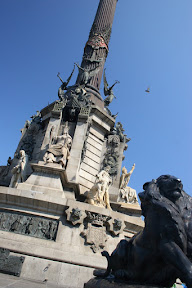
We finally made it to the sand only to find that in seemed to stretch on forever which was a good thing, considering it was PACKED with people. As we walked along a wooden boardwalk looking for a place to lay our towels, we were immediately thrown into European beach culture. Tops were optional and bottoms were minimal. In fact, underwear seemed to qualify as swimsuits for many. We passed a topless girl on the payphone and guys strutting around in their tighty whities.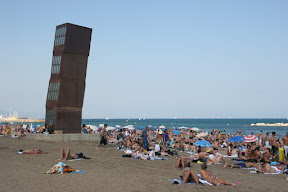
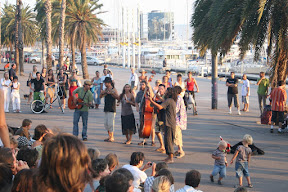
That evening we wandered around the Barceloneta district looking for a place to eat. Along the way we were distracted by a band performing local music to a spontaneous crowd. When we were too hungry and thirsty to stand it, we decided on a restaurant (recommended by the Lonely Planet) . Unfortunately, we found out it was full, with a crowd waiting outside on the street, and couldn’t figure out how to put our name on the list (no habla ingles), so we gave up on the restaurant idea, settling for a beachfront bar instead. It was colorful, cozy and had a fun atmosphere, but most importantly it had food and drink. Since our waitress didn’t speak a word of English I finally threw out “dos mojitos” which made her smile, nod and return with two of the best mojitos we had ever had!
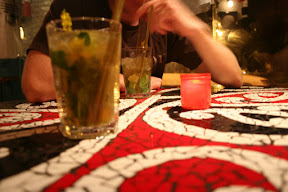
Sitting there trying to read the menu, we hit a tourist low when we had to pull out the travel book and literally translate the menu to figure out what the heck to order. (The worst part is that I do know a little bit of Spanish, but they actually speak Catalan in Barcelona. Although it’s a form of Spanish, it was just different enough to throw me off.) The waitress noticed our dilemma and offered nachos, which we jumped at and then we eventually settled on a couple of sandwiches (with something or other on them)… just as the manager came over and asked, in great English, if we needed any help! After the best guacamole ever, a few more mojitos, and some time watching the entertaining crowd (fire breather included), we’d decided we loved this place!
29 July
The next day we set out to explore the Barri Gotic (Gothic Quarter). This medieval district is made up of 13th-15th century buildings. It was a really amazing display of gothic architecture that was in great condition. As recommended, we wandered the narrow streets twisting and turning through allies, shop lined streets, and tucked away plazas (plaças). First was Plaça de Sant Jaume which was quite busy and large and flanked by large government buildings. We picked one of it’s many off-shooting streets and immediately found a Moaz restaurant. Ever since my sister Rachelle went to Spain a few years ago she had been raving about the falafels and had specifically recommended Moaz. I jumped in line and ordered a falafel (they’re fried balls of ground vegetables & chick peas served in a pita with hummus and a variety of sauces and fresh veggies, etc.)… it was delicious!
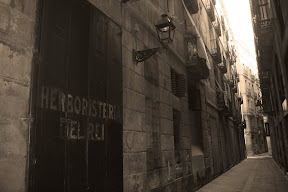
The Catedral (Cathedral) de la Seu, is one of the Barri Gotic’s main sights and we made our way there next. We came upon it from the back and explored the outdoor courtyard and ribbed vault walkways. Continuing around to the front we were discouraged to find that it was covered in scaffolding and a huge banner that blocked nearly the entire façade! We soaked up some sunshine in the plaza while we looked at pictures of what this amazing gothic cathedral should have looked like.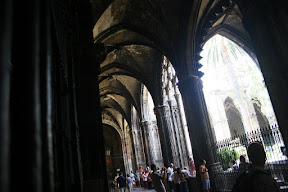
We carried on to the Plaça del Rei (King’s Square)and found ourselves wandering through the Conjunt Monumental de la Plaça del Rei which had a beautiful interior courtyard with an Italian feel. It was a museum of the city with underground Roman ruins (which we didn’t catch on to at the time). The narrow, balcony lined streets lead us on to Santa Maria del Mar with its famous square. It was a cozy space defined by the high walls of surrounding buildings with cafes that spilled out into it, but it was so small I could hardly get a decent picture. I was caught up in the details of this whole area… metal gates, signs and accents, all kinds of stone and random graffiti, not to mention the architecture itself. Everything was very large scale, but somehow it had a really intimate feel to it.
Barcelona is notorious for having a lot of graffiti, but it’s said to be some of the best there is. Andy and I were pleasantly surprised to see that it was generally contained to non-historic, less important parts of buildings, particularly rolling metal doors. I guess as far as graffiti goes, it wasn’t too bad!
High on our list for today was the Museu Picasso (Picasso Museum ;)), so we went there next. It’s a popular place, so we had a wait in line but it was worth it. The museum spreads across five medieval mansions In the La Ribera district. Picasso lived in Barcelona as a teenager and his friend founded the museum and donated his entire collection upon his death. Picasso then took an interest in it and as a tribute to his friend, donated many additional works. We really enjoyed the museum since it traced Pablo Picasso’s entire life and showcased all the different type of work he did (not only the cubism he’s most famous for). The Las Meninas (1957) series of 58 paintings is one of the highlights, which was his Cubist reinterpretation of the original Las Meninas by Diego Velazquez.
Andy was famished by this point so he picked up a kebab and we wandered into a residential part of the district to rest on a bench in the only patch of shade we could find. We were up for more exploring, so we continued east through La Ribera and found the Arc de Triomf. We took some pictures in front of the huge brick structure and rested in its shade (and found that its base had a perfect seat built in the layers). Barcelona has this great bicycle program that let’s people pick up and drop off bikes all over the city. We sat there watching people do this wishing that we could too, but we couldn’t read the limited instructions.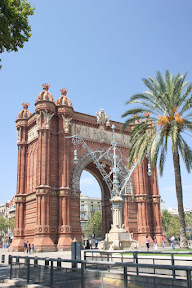
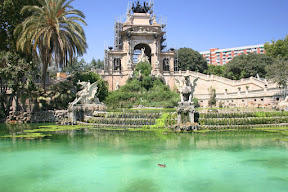
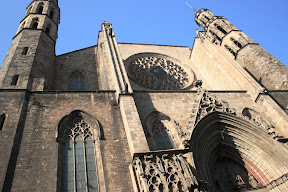
30 July
Today’s main destination was La Sagrada Família. It is the symbol of Barcelona and the most notable work by Antoni Gaudi. His name and Barcelona go hand in hand due to his amazing architecture scattered throughout the city. This church was his final masterpiece and it is still under construction to this day. After learning about it in Charney’s History of Architecture class and seeing my sister’s pictures from her visit, I was dying to see it!
I think it deserves a little background… Construction began in 1882 on this Catholic basilica, formally called the Temple Expiatori de la Sagrada Família (Expiatory or Atonement Temple of the Holy Family). Antoni Gaudi took over the project at age 32, worked on it for 40 years, and completely devoted the last 15 years of his life to the project. In his later years, he lived in a hut on site, refused a salary, wore shabby clothes and begged for money to continue work on the project.
He intended for the church to be the “last great sanctuary of Christendom”. Every detail of every part of it has religious symbolism which as led to it being called a catechism in stone. It was envisioned to have 18 tall towers representing: the Twelve Apostles, the four Evangelists, the Virgin Mary, and Jesus Christ (the tallest) and 3 grand façades: the Nativity (east), the Glory (south), and the Passion (west). The Nativity façade and its towers were completed by Gaudi and his intricate, decorative, organic design style is evident while the Passion façade has been completed since his death with a completely different style by Josep Subirachs (which is angular and bland to reflect the sad period in Christ’s life – and to not directly mimic Gaudi’s work.)The original exterior has a fluid, organic look and includes biblical statues, plants, birds, colorful mosaics, and prayer words that give an insight into Gaudi’s eccentric nature and devote Catholicism.
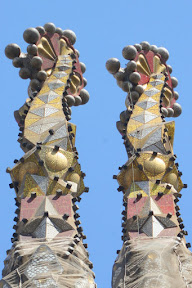
“My client is not in a hurry,” is how Gaudi explained the long construction period. After his death in 1926, work carried on until the Spanish Civil War in 1935, then began again in the 1940s and continues today. They hope to complete the church by 2026, for the centenary of Gaudi’s death. Gaudi designed much of La Sagrada Família in plaster model form and kept the rest in his head, literally directing every part of construction himself. Sadly, almost all written or drawn plans he did have (as well as his models) were destroyed in an anarchist riot in 1936, ten years after his death. Even though there is no way of knowing what the finished structure would have looked like, building continues.
I was utterly amazed to see this masterpiece in person. It’s one thing to see a historical building that has been standing as it is for hundreds of years, but it’s really another to see one that is still being designed and built right in front of you. This sort of massive construction with such detail really isn’t seen today and it’s great to have seen it firsthand. We arrived by subway and came up from the station wondering which way to go when we turned around to find it looming over us, directly across the street. The tallest of the (completed) towers is 112m/ 367ft and its overall size is completely overwhelming! (The envisioned final tower will be 170m/ 558ft high!)
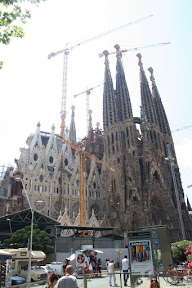
We took pictures from a distance before walking around the exterior attempting to take it all in. This is harder than it seems though, since the church is set in the middle of a city that carries on its business all around it. We continued around to admire the Passion Façade from a park across the street before lining up to go inside. Our audio-tour led us through the working construction site that is the interior of this massive church after we got a closer look at the harsh statues that decorated the façade. Once inside we could better appreciate the multi-colored stained glass windows that lit the entryway. The interior columns resemble trees and form a “forest” that becomes a hyperboloid vaulted ceiling with mosaic tiles. (Gaudi extensively studied hyperboloids and forms in nature. Both show up throughout his architecture.)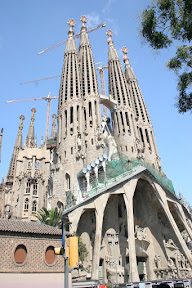
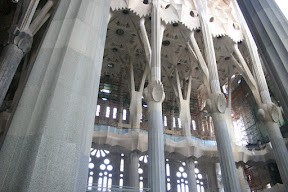
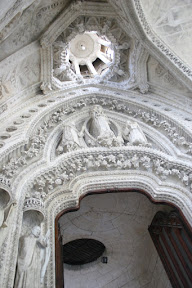
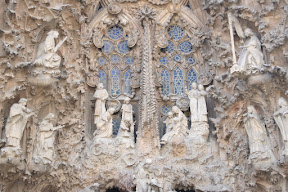
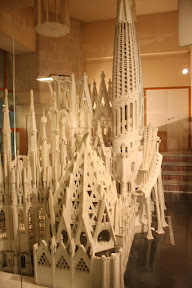
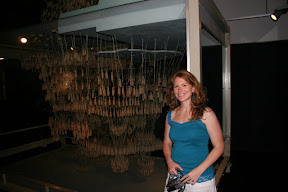
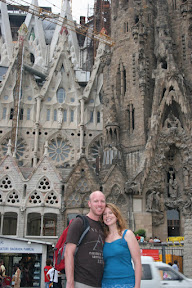
That evening we decided to treat ourselves to traditional Spanish paella! We consulted our travel book once again and found a place in Port Olímpic along the waterfront (this whole area was created for the 1992 Olympic Games that were held here). It had a view and was right next to Frank Gehry’s Fish sculpture. Even though it was around 8 p.m., we dined nearly alone in the restaurant since people in Barcelona dine late at night. We ordered the recommended seafood paella (a baked rice dish) and were excited when it was served in the traditional huge pan for us to share. We have to admit that it wasn’t our favorite, but it was definitely worth a try. To finish off the evening we couldn’t help but take another trip back to our favorite seaside bar for some mojitos!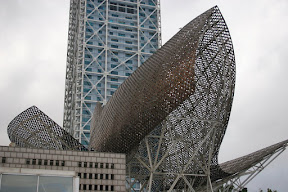
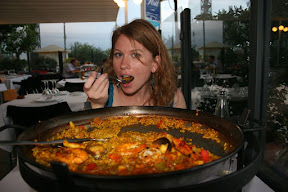
31 July
Today we set out to see more of Gaudi’s architecture. We took the subway to the Passeig de Gracià, an elegant street full of upscale stores, unique design shops, cafes, and apartments. It also has the highest concentration of architecture from the Modernista movement in the world. We stopped at Vincon a really cool shop with European high design “stuff” from office supplies to furniture to toys and upon leaving, realized we were right next door to Gaudi’s Casa Milà! We had a look at the exterior (and the long entry line) before deciding to come back later.
Just diagonal from Casa Milà was the Manzana de la Discodia, a row of the most famous Modernisme (Art Nouveau) buildings in the city. Casa Batlló by Antoni Gaudi, Casa Amatller by Josep Puig I Cadafalch, and Casa LLeó Morera by Lluis Domenench I Montaner were all quite different in style, but all stunning. We spent some time admiring the façade of Casa Batlló before joining the entrance line.
Completed in 1906, Casa Batlló incorporates many of Gaudi’s principle design elements such as colorful mosaics and inspiration from nature. The entire façade is covered in a rainbow of glass and ceramic mosaic as it represents the legend of St. George (Catalonia’s patron saint) and the dragon. The roof shows the humped back of the dragon with tile scales, the bones of victims are seen in the window frames, and the balconies form their skulls. At the top, a turret and cross represent St. George’s sword. Inside there are nearly no straight lines as everything seems to curve and undulate as in nature.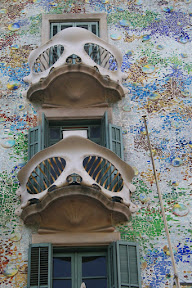
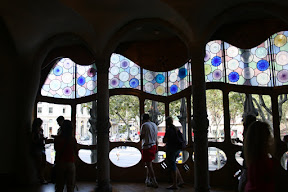
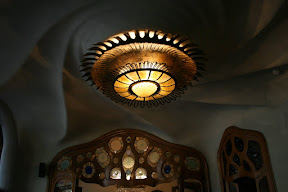
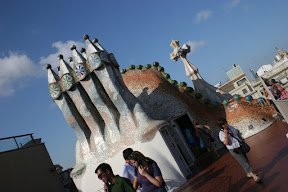
Tapas for lunch were a nice break. Tapas are such a great idea (and Spain’s most notable culinary contribution) for a quick and easy meal. They’re generally pre-made and lined up along counters so that you can walk around and see you food then just point at what you want. They’re heated (or quickly made) then served as they’re ready and the portions are really small so you can order several and share easily. We had them quite a few times, but I have to admit that the choices were sometimes a little odd for my taste.
We spent some more time wandering along the Passeig de Gracià window shopping and enjoying the weather. Our attempts to find an information booth to get some visitor discount cards failed, so we stopped for mojitos instead. Later, we took the subway back to the end of Las Ramblas where had dinner at a Hard Rock Café… I know, I know, but we were dying for some American food!
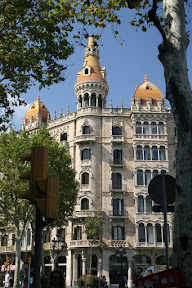
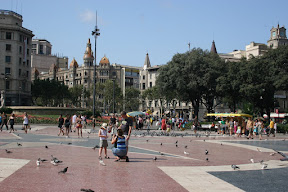
1 August
Today we started back at Casa Milà, but this time for a tour. Its amazing exterior is like one huge undulating stone formation with delicate iron balconies (it’s said not to have a straight line). It was even nicknamed La Pedrera (the quarry) because of the huge amounts of stone used… and because it wasn’t popular at the time it was built, but it is now seen as the climax of Gaudi’s genius (and his last work before La Sagrada Familia).
We saw the beautiful interior courtyard and looked at just a few rooms as the rest is still private apartments. The apartments we saw were restored to the early 20th century so we could get an idea of what it looked like at the time it was built in 1912. From there we went to the upper floors and the Espai Gaudi, an exhibition of Gaudi’s life and work. Its whole structure is created by hundreds of brick arches which give it a really unique feel. Here we saw many plaster models and photo graphs of his work as well as another hanging model.
Finally, up to the roof terrace! This is what Casa Milà is famous for, a waving deck with highly sculptural chimneys and ventilation shafts. The whimsical sculptures are decorated with broken champagne bottles, ceramic, and marble and show how Gaudi could take something functional and give it a sense of fun. We wandered up and down the paths and around the sculptures taking in the amazing view… and taking lots of photos.I mentioned earlier that the weather on the beach was warm and sunny, but I have to mention again how beautiful the weather was in Spain. After unusually cool and rainy weather for the first part of our trip, this was an extremely welcome change! Granted, it did get pretty hot and the humidity was overwhelming at times… but I think that people there just figure that having to break a sweat walking one block at 11 p.m. at night is just the price you have to pay. Hey, we even managed to get a bit of a tan (not a small feat for us)! After a lot of tours in the last couple days, I was really looking forward to spending some relaxing time at Park Güell. This was another one of Antoni Gaudi’s amazing creations… but was very different than I expected. Since this park was originally a private commission for a client’s estate outside the city center, we had to take the subway and a small hike to get there.
As we walked up the hill to the main gates, Gaudi’s signature mosaics greeted us right away. (Trencadis, in Catalan, is a method of piecing together broken pieces of pottery and glass to form an abstract mosaic. Gaudi’s fullest expression of this is found in Park Güell, but no one knows whether it was planned or if he discovered the technique by accident. One of my travel books said that he became so obsessed with it that he sent his workers to other building sites to scavenge for broken bottles and tiles and had them shatter new supplies when they arrived.)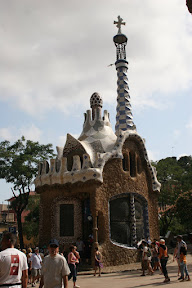
As we entered the park we saw the fairy-tale like buildings that flanked the gate and headed towards the main stairs. Due to the large crowds, we opted to take a detour and come back to it later. We ventured up a winding path that eventually took us up to the Sala Hipostila. The “Hall of 100 Columns” (actually 86) is a roof supported by columns that was intended to be a covered market, but is now just a beautifully mosaiced space. It was nice and cool inside, so we stopped for a rest and to look at the amazing ceiling with circular mosaics that represented suns and moons.
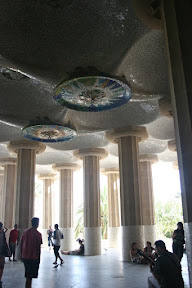
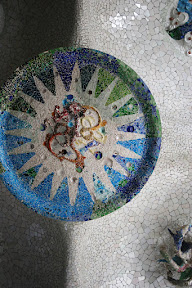
We continued up another flight to see the porticoed walkway edged with slanted columns that resembled tree trunks (made from materials found on site) and then up to The Square. I had seen many pictures of the park, but this space surprised me as it was wide-open, barren and sandy with only the “serpentine bench” that the park is so famous for along its edge. Quite high up on the hill, The Square had a great view so people lounged all along the colorfully tiled bench. It was covered in a huge variety of tiles and ceramics and changed with every curve. Later, we found out that the sand on the square was designed to filter rainwater down through the columns and into an underground reservoir.
We were getting scorched in the sun, so we took a quick break at the café (where I chatted with a couple from California who had just come from Paris on their way to London – just opposite of us) before taking off in search of a nice green lawn to relax on. Apparently though, there are no grass lawns in this park! (Well, we did find a small patch just as we were leaving, but it was roped off and had a no walking sign!!) Instead, we wandered up winding paths that lead us up for higher views of the city and all around the huge park. Eventually, we made our way back to the main stairs where we watched the crazy crowds before finally working our way down to get a picture with the notorious tiled salamander fountain.
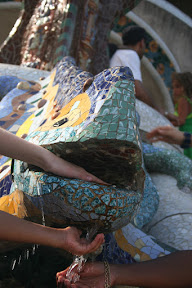
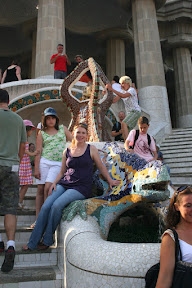
2 August
On our last full day in Barcelona we decided it would best be spent on the beach! First we had another visit to the huge food market to pick up some fruit (and so that I could take some photos… it was so colorful). We took public transport to a place farther down the shore to get another view. The crowds were still thick, but we “worked on our tans” all afternoon just relaxing. The breeze was cool, and from our earlier trip we thought the water was cold, but we finally got brave enough to test it out and it was great. The sea was a really dark blue color, but was actually crystal clear quite far out. We had a great time playing in the waves and having some cervesa at the beachside café… even if the stretch of sand nearby was clothing optional.
3 August
On our last day in Spain I was anxious to revisit some of my favorite places and shops. We started with another visit to the Barri Gotic where I visited my favorite jewelry shop, Noa, to get some more stained glass earrings and colored wooden jewelry for myself and family. We wound in and out looking at a few more shops before stopping for a quick pizza lunch and then on to Las Ramblas. We had seen so many artists displaying their paintings I had to get one! It was a tough call, but I finally chose a brightly colored, stained glass-like, painting of Casa Batlló.
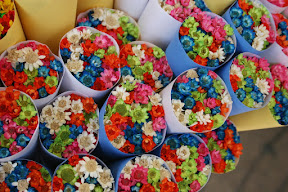
We gathered up our things from the hostel storage and began the trip to the airport. It was hot, we were sweaty and Andy had found a less crowded walk to the airport bus stop… part of it just happened to be right through a neighborhood that was lined w/ hookers! Andy wasn’t sure at first, but I assured him that the crossed-armed guys standing at every few doorways and the girls standing around in skin tight lycra in the middle of the day was probably a sign. We eventually dragged our bags all through town, caught the bus to the airport and took off for Paris.
